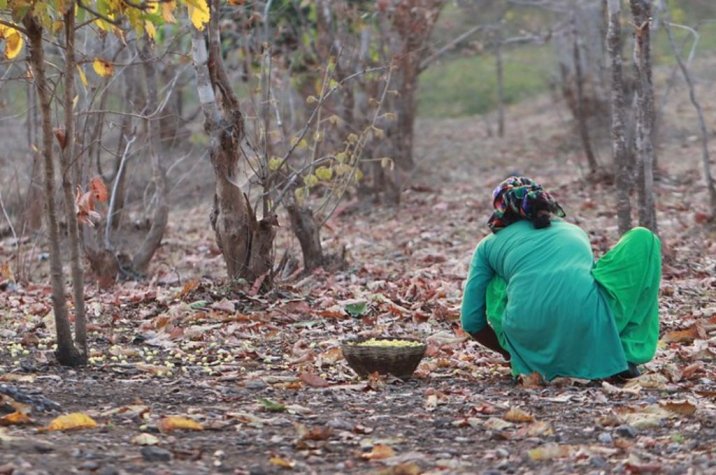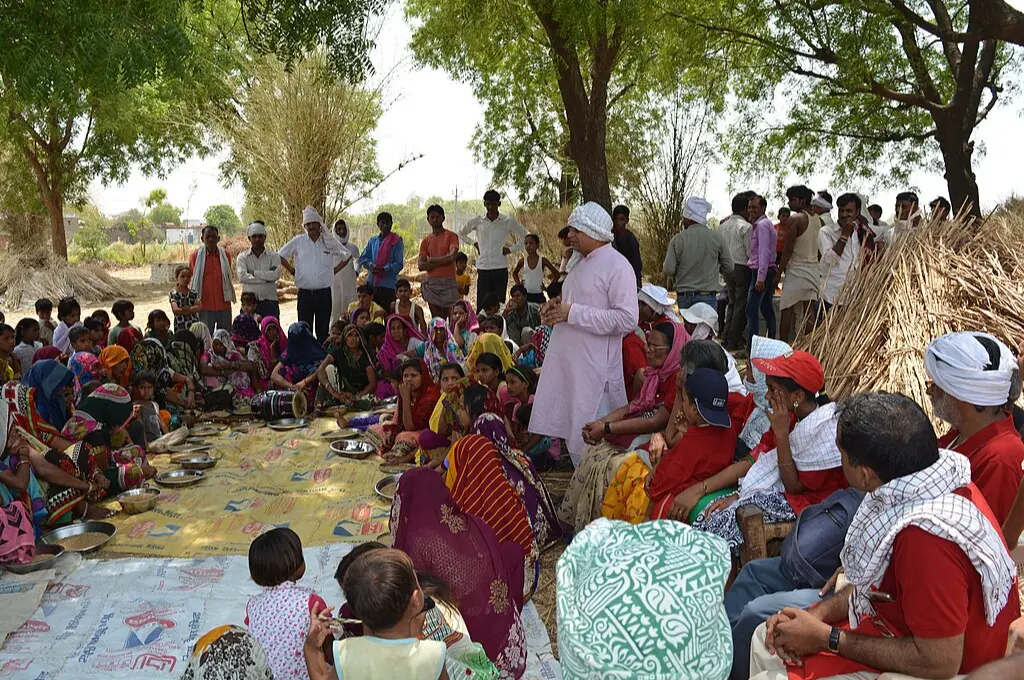Adivasis constitute 8.6 percent of India’s population, but they have been continually excluded from the nation’s idea of development. Livelihood generation projects, conservation measures, and health and education programmes have been framed without taking into account the Adivasi world view. They have rarely had a say in the programmes planned around their lives and land, and find themselves in the bottom rung of the human development index.
In 2020, when the pandemic hit India, they were understandably among the most affected communities. In states such as Chhattisgarh, with an Adivasi population exceeding 30 percent, livelihood activities, particularly those linked to forests, were disrupted during the lockdown. The state ran into vaccine shortage and the weak public healthcare system struggled as COVID-19 cases rose. But there were some silver linings. Work under MGNREGA provided employment to many Adivasi people. The public distribution system (PDS) was functional, and nonprofits in collaboration with the government used it to deliver food staples such as rice to marginalised communities.
We spoke to nonprofits and activists working in Chhattisgarh to understand how Adivasi communities in the state were impacted by the pandemic. Through these conversations we learnt about the specific challenges faced by Adivasis during the pandemic as well as the structural issues that have plagued their lives for decades. Responding to these challenges requires an understanding of approaches that have been successful, alongside a recognition of the problems that go far beyond the pandemic.
What worked?
1. Practising layered livelihoods
PRADAN, a nonprofit that works on rural livelihoods, found that communities that adopted diversified livelihood activities coped better during the pandemic. According to Tamali Kundu, who leads PRADAN’s Chhattisgarh operations, and her colleague Mohini Saha, communities that practised a combination of activities such as fishing, mixed agriculture, intensive vegetable farming, and livestock rearing were not as badly affected by lockdowns and market closures. During lockdowns, this approach increased availability of food, minimised risks related to selling produce in the market, and enabled interdependence and self-sufficiency within villages. It also offered a lesson for sustainable livelihoods. PRADAN has found it beneficial to support communities to carry out a combination of livelihood activities based on their traditional skills and knowledge as well as the context and demand of the market.
2. Cultivating women’s leadership
Tamali observed that ongoing efforts by government agencies and nonprofits to collectivise women and cultivate their leadership at the grassroots proved advantageous during the pandemic. “Women’s collectives took the lead, starting from identifying vulnerable households at the village level, whom to support and how—be it rations, medical, or livelihood support. In Chhattisgarh the National Rural Livelihoods Mission has a presence in every district and supports SHGs and their collectives at different levels, beginning from the village. Some SHG members have been trained as community resource persons and so they can extend their support to vulnerable households.”
During the pandemic, when reaching communities directly became difficult, women leaders started to play a vital role.
PRADAN wasn’t alone in seeing the dividends of its investment in building capacities within the communities during this time. Lata Neetam, founder of Lok Astha Sewa Sansthan (LASS)—a Chhattisgarh-based nonprofit that works on women’s land rights, gender violence, and education—had a similar experience. Since its inception in 2005, LASS has worked on building women’s leadership in Adivasi communities and representation in local governance. During the pandemic, when reaching communities directly became difficult and the nonprofit’s work expanded to responding to health emergencies and distress calls, these leaders started to play a vital role.
Lata says, “As there was an increase in cases of domestic violence during the pandemic, our women leaders coordinated with us on the complaints they received and we would facilitate the rest of the process. There were times when we arranged police cars for the complainants to reach the sakhi centre.”

3. Enhancing digital and financial literacy
People living in remote areas had limited access to cash during the pandemic. Banks and ATMs were often too far to reach when people’s mobility was curbed. In this context, bank sakhis (women trained as banking correspondents) and community members with digital access and training played an important role in helping communities access cash and make and receive payments at their doorstep.
Nonprofits also utilised WhatsApp extensively to deliver training materials, precautionary measures, and isolation instructions, along with holding in-person sessions and webinars with community resource persons to spread vaccine awareness in the villages.
While digital education was promoted by the government as an alternative for children when schools were shut, internet access and literacy proved to be a huge barrier. LASS found that the community members whom they had previously trained in teaching and digital literacy could tutor the children who did not have access to mobile phones during the lockdown.
Nonprofits’ investment in digital literacy of community members proved to be extremely beneficial when essential services were hard to reach and normalcy of life was interrupted during the pandemic.
4. Leveraging government schemes
Employment schemes such as MGNREGA provided work and a source of income to a large number of Adivasi people, especially notable as there were limitations on many activities. Tamali says, “MGNREGA was helpful, and new job cards were made which gave people work. This was done proactively in all districts—maintaining a detailed record of the migrants, whether they got job cards or not, whether they got work or not.” She adds, “In Chhattisgarh, people who hold Individual Forest Rights are entitled to 50 extra days of MGNREGA work. During the pandemic, there was targeted implementation of this provision.”
However, in districts such as Gariaband, where LASS works, nonprofits had to intervene for MGNREGA work to be resumed during the lockdown. Lata says, “We heard from our women workers in the community that work under MGNREGA had stopped. We went to the programme officer and explained that people would die of hunger before they died of COVID-19.”
According to Tamali, the Van Dhan Vikas Yojana was helpful for the Adivasi communities that are heavily dependent on the sale of non-timber forest products (NTFP). The communities collected their produce and took them to the aggregation centre that functions under Van Dhan Yojana, and the centre facilitated sales at a good price in the market.
5. Gaining the community’s trust
Nonprofits that work in Chhattisgarh emphasise the importance of building trust within the community. With good reason, Adivasis see outsiders as exploiters. The first step in this direction is to demonstrate that the organisation is working with the community and not making decisions on its behalf.
Tamali says, “From our own experience, we have learnt that when people see you engaging with them more empathetically, they speak their mind. This helps you to understand their specific need. Rather than imposing your approach, you should build on their need.
Challenges that demand structural changes
While some Adivasi communities have benefitted from government schemes and nonprofits’ efforts, persistent systemic failures continue to affect the lives and livelihoods of more remote and vulnerable communities. Their struggles throw light on structural problems that go far beyond COVID-19. Here are some of these issues:
1. Lack of access to forests
Adivasi people who live near forests survive on the produce that they collect from these areas. Their livelihoods revolve around gathering and selling NTFPs. Lata says that in the districts where LASS works, the communities weren’t allowed to enter the forests during the lockdown. They naturally struggled for food and income. The Adivasis were locked in their homes, while there were reports of the forest department continuing with an afforestation drive.
Government schemes such as MGNREGA that provide an alternative source of income in times of distress do not reach communities in remote areas and are not designed to provide work that can be taken up by forest-dwelling communities. Consequently, they do not have access to safety nets that can help them tide through crises.
2. Poor implementation of laws
The exploitation of forests and forest-dwelling Adivasi people continues despite the Forest Rights Act, 2006, which recognises the rights of forest-dependent communities over their land. The act provides individual rights of self-cultivation and habitation as well as community rights to grazing, fishing, and access to water bodies in forests. It recognises traditional customary rights and the right to protect, regenerate, conserve, or manage any community forest resource for sustainable use. The act protects the Adivasi population from eviction without rehabilitation and settlement. It also emphasises the role of the Adivasi-constituted gram sabha in conserving and protecting the natural environment and deciding the local policies and schemes that affect the communities.
The government has continued to tweak the existing laws to make way for ‘development projects’.
However, having a law isn’t enough unless it is properly implemented. An Oxfam report illustrates how, despite the act, forest rights are regularly overlooked by the government. The situation hasn’t changed much over the years. The government has continued to tweak the existing laws to make way for ‘development projects’.
In the midst of the pandemic, the government made the forest department the nodal agency for community forest rights, giving it unbridled power. The decision had to be reversed after protests from the communities and activists.
Ramesh Sharma, national convener of Ekta Parishad, a people’s movement, calls the state’s move a clear violation of the legal framework of the Forest Rights Act, which mentions that only the tribal affairs ministry or department of the government can legally lead such a position. Ramesh says, “The forest department has an undue advantage because of the Indian Forest Act, 1927, [a draconian, colonial law] and the Forest (Conservation) Act, 1980, which allows them to continue injustices against the Adivasis.” In the past, the forest department has been accused of injustices such as denial of forest rights, encroachment of forest land, and illegal eviction of Adivasis.
The Forest Rights Act was introduced to undo historical injustices and the tribal department was appointed as a nodal agency for its execution. However, according to Ramesh, the tribal department itself is not institutionally empowered and can barely survive as it receives minimum resources and lacks commitment to the rights of tribal communities.
3. Weak public health infrastructure
Chhattisgarh’s public health infrastructure has been historically poor. Although the current government came into power with the promise of universal healthcare by focusing on affordable government-led medical care, it has shifted its focus to favouring private hospitals.
The Adivasis’ lack of trust in the government and its facilities are amplified by the poor returns they receive from visiting public healthcare facilities. In many cases, they fall back upon practitioners of traditional medicines from their community. Ramesh says, “There’s been no health infrastructure in place for Dantewada or Bijapur for the last 30 years or 40 years. If there’s oxygen shortage in the capital city of Raipur, you cannot even imagine the condition of the people who are actually dying in the remote areas of the state.”
Ramesh believes there’s a need to recognise indigenous medicines and include indigenous medical practitioners in the government health infrastructure, instead of discounting them as backward and unscientific.
4. Lack of trust between the government and nonprofits
There is a trust deficit between the government and nonprofits, which is not particular to Chhattisgarh alone. Grassroots nonprofits have immense knowledge of the communities and geographies they work with. In Chhattisgarh, too, they have a long history of struggles and victory by working on the ground. Ramesh, who was part of the drafting committee of the Forest Rights Act, says, “The Forest Rights Act was a result of the effort of many social movements. It isn’t a law that was drafted somewhere in the Planning Commission or in the Ministry of Law; it was actually drafted by leaders of the people’s movement.”
He rues how even after all these years the act hasn’t been properly implemented, and advocates the need for an implementation committee or task force. “If the government has limited capacities, they must understand that they need the help of the social sector organisations because we’re strong on the ground. And we’re always ready to help.”
Lata, who belongs to the indigenous Gond community of Chhattisgarh, concurs with Ramesh’s views, and adds that even funders need to trust grassroots nonprofits with funding as they are capable of responding to the immediate needs of the community.
COVID-19 has made life difficult for Adivasi communities. However, the analysis of their struggles cannot be limited to the period of the pandemic and lockdowns. The root cause of the problems they encounter lie elsewhere—in poor policy implementation, lack of engagement with the Adivasi people and their issues, and continuous exploitation of their homes and livelihoods.
—
Know more
- Read how climate change is affecting the yields of forest products in Central India.
- Learn how urbanisation affects Adivasi communities.
- Understand why implementation of Forest Rights Act remains a challenge.







